Google’s featured snippets: the biggest slice of the SERP pie?
SERP features make the most helpful results stand out, and among them, featured snippets are the biggest attention stealers. When a page gets featured for a certain query, the snippet takes up a lot of the screen’s real estate (sometimes, all of it) so searchers can’t miss it. It doesn’t come with a surprise that the more visible the page is in the SERPs, the more visitors it gets.
But what is the real correlation between snippets and clicks and how valuable are those snippets for SEO? In this post, we’ll explore the history of featured snippets, their types, and the influence they may have on search optimization.

What are Google’s featured snippets?
A featured snippet is a block of content pulled from a web page as it’s most relevant to the query and is placed in the zero position in the SERP, leaving all other results below. It is called a featured snippet because, unlike a plain blue listing, it features a certain part of a page. While regular snippets are generated from the title and description tags, featured snippets adjust to the query and pull out the most relevant information. Google believes that snippets make it easier for users to find what they’re searching for because it puts essential details above all other results.

A brief history of featured snippets
Featured snippets were first shown in January 2014. They sometimes were called Google’s “answer boxes” or Google’s “quick answers” and were primarily associated with short questions to queries. That year already, website owners and SEOs realized that they could profit from this innovation, which spurred a range of articles describing how to optimize for featured snippets.
Even though the SEO community had already used the term, featured snippets were officially named so in 2016. At that time, short answers pulled out from Google’s database with no reference to a particular source were no longer confused with featured snippets.
Most types of featured snippets were released at the same time, only carousel snippets came later, in 2018. We’ll cover all of the types later.

The notable thing about the early years of featured snippets is that they allowed web pages to be duplicated, featured above the rest and as a regular snippet as well. When in January 2020, Google rolled out the deduplication update and featured pages were no longer shown twice, it led to a significant CTR decline.
The deduplication update also put an end to featured snippets showing in the right sidebar. Now, only knowledge graphs can be placed both on the right sidebar and at the top of the search results.
There have been some unsuccessful innovations introduced to featured snippets. For example, in 2020, Google tested placing multiple contextual links from different sources into a single snippet. While it could be good for the sources that would get featured, it wasn’t good for a featured web page as it would include links that weren’t originally there.
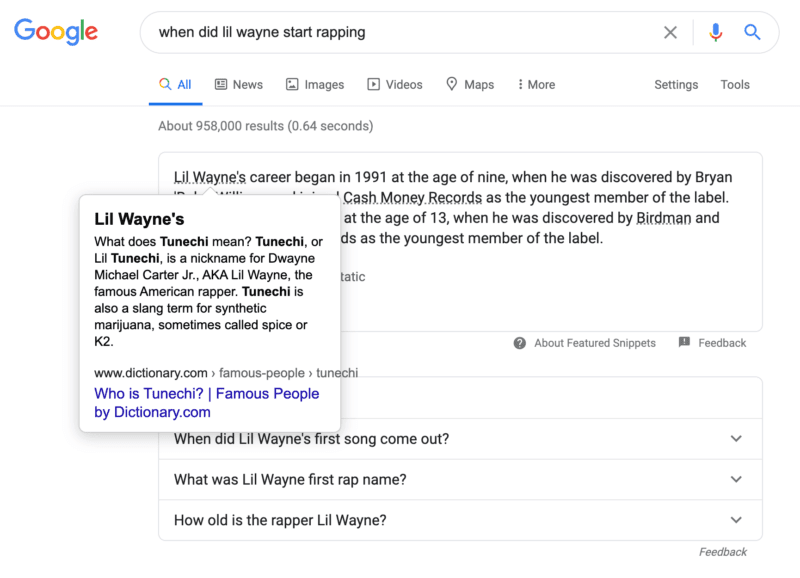
It was also spotted that Google could combine a text block from one page with an image of a different page. We couldn’t find anything like that and even if there are featured snippets left that combine information this way, they are likely to go away.
Currently, Google is experimenting with the “hear this out loud” button available for searchers in India. The feature triggers Google Assistant to read the snippet. Also, the search engine is testing the “also covered on this page” section that works similarly to Google sitelinks and gives hints on what other sections a web page includes. Who knows what other types are yet to emerge in the SERP as featured snippets.

Why should you care?
The most obvious answer is, featured snippets are impossible to miss out of sight. Especially on mobile devices where they take no less than half the space and sometimes more:
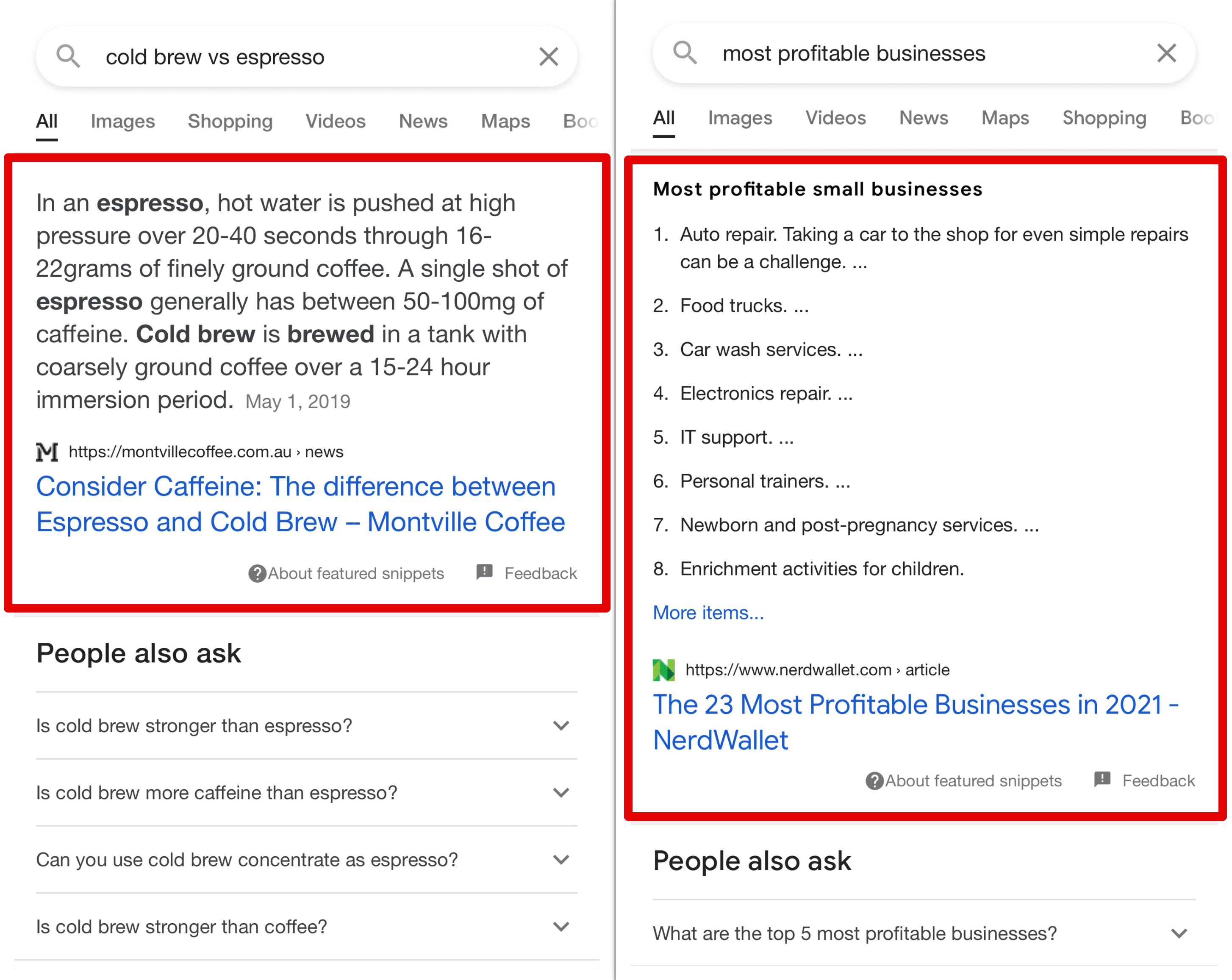
Even though they take an awful lot of screen space, they don’t always give a direct answer to a query and motivate users to learn more from the featured source. Statistics demonstrate that more often than not, users do follow featured links, which makes the high level of clickability a major benefit.
High click-through rates
Ahrefs’ 2017 study revealed that pages with featured snippets get over 8% of clicks from the SERP, stealing a portion of clicks from the first plain blue link result. The first result still gets more, and as CTR statistics show, the second and third positions do too, but if you’re ranking lower, the featured snippet might be your solution. Even though the study is a couple of years old and was conducted before the deduplication, its insights are still relevant, especially for pages getting to the top 10 but not to the top 3.
According to AuthorityHacker, 60% of search snippets are owned by sites ranking below the first position. And speaking of carousel snippets, one third of the sources triggered by bubble modifier aren’t even in the top 10 for the query.
BTW, you can check the “real” ranking of any web page with a snippet: just add “&num=9” to the URL, and you will see the snippet-free listing. This hack explained on Twitter allows you to exclude a featured snippet from the SERPs you’re seeing and specify how many results will be shown (in the number after “&num=”).
A more recent study by EngineScout showed that featured snippets received over 35% of all clicks. It’s a bit hard to believe in this exact number given that the first link gets slightly over 25% on average, but it’s safe to say that featured snippets do generate traffic and you should consider optimizing for them.
If you don’t want your pages to get featured or you want to limit the snippet’s size, Google offers several ways to do so, but as experiments show, opting out of featured snippets will lead to a traffic loss.
What impact did the deduplication update have?
In early 2020, SEOs were concerned their websites would get fewer clicks because of deduplication. There was a significant decline observed in the first days after the update, however, there’s no evidence to believe that it will negatively impact the CTR in the long run. For instance, g2 actually increased its traffic from featured snippets after deduplication, but only on desktop.
Engagement with voice searchers
Besides the idea of featured snippets increasing traffic, there’s another clear benefit related to type-free search. It’s been observed that most of the queries formulated by voice search have featured snippets. If you have those snippets, there’s a good chance you’ll attract searchers who use digital assistants, and there are a lot of them. For instance, over 70% of US users prefer voice search over typing.
Types of featured snippets
There are several types of Google’s snippets that are currently well-established in search: paragraph, listing, table, and video. There are also less common types that contain bubbles with specifications, include several web pages, or display two different opinions. Google continuously reevaluates its methodology of generating featured snippets and is running tests on some new snippet types. Let’s take a look at each snippet variation.
Paragraph snippets
The simplest type of featured snippet is a single paragraph that either gives a short answer to a query or provides a hint on what information a web page contains. It is usually accompanied by images but sometimes it’s just merely a text paragraph:
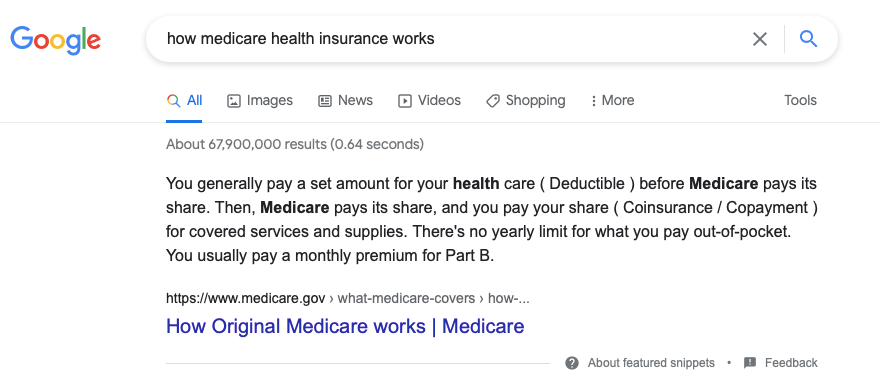
Words included in a query or semantically similar ones are often highlighted in featured snippets, as well as subsections that might be pulled out from a page to provide an informative overview:
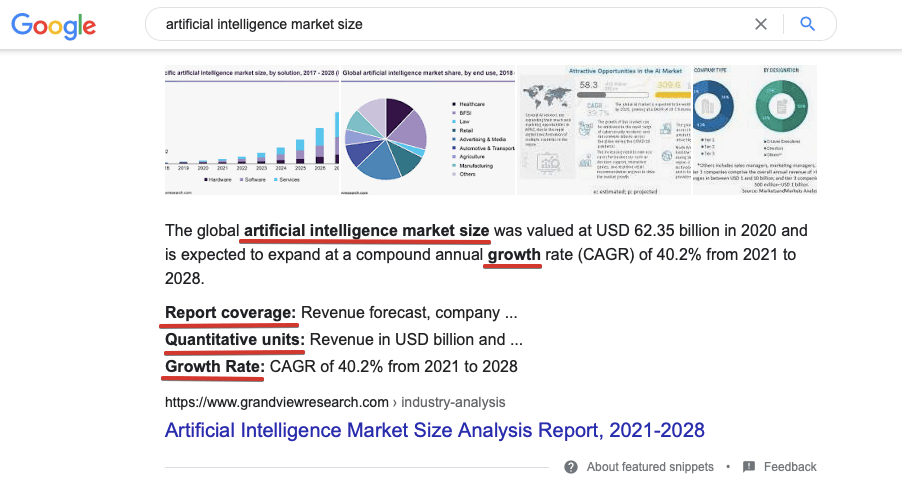
Google always offers an option to leave feedback and indicate if a snippet violates any content policy. Sometimes, the search engine asks if the information is helpful right in the snippet:
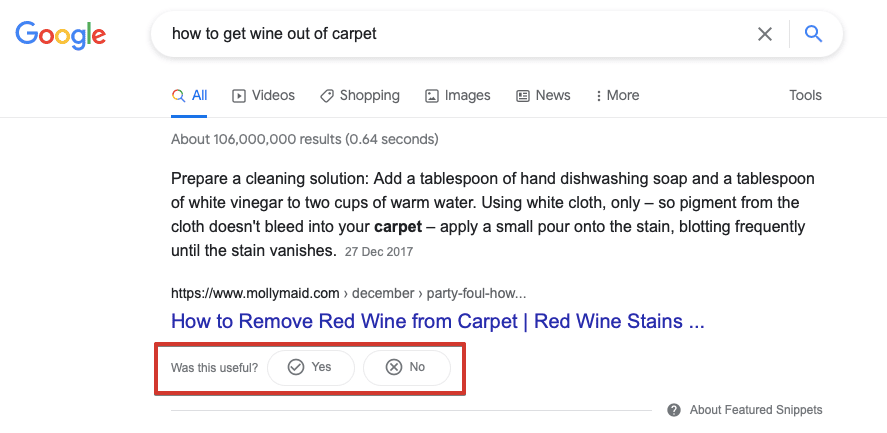
Video snippets
Most videos that appear as a featured snippet address a popular how-to query. They even have a certain part of the video highlighted and quoted:
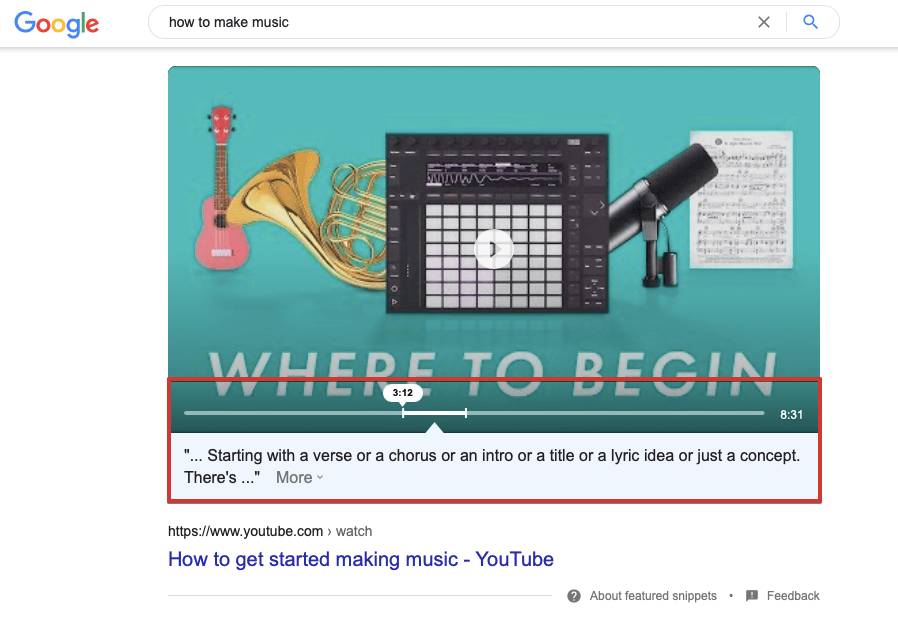
Also, a lot of searches focused on processes that are easier visualized receive a video snippet:
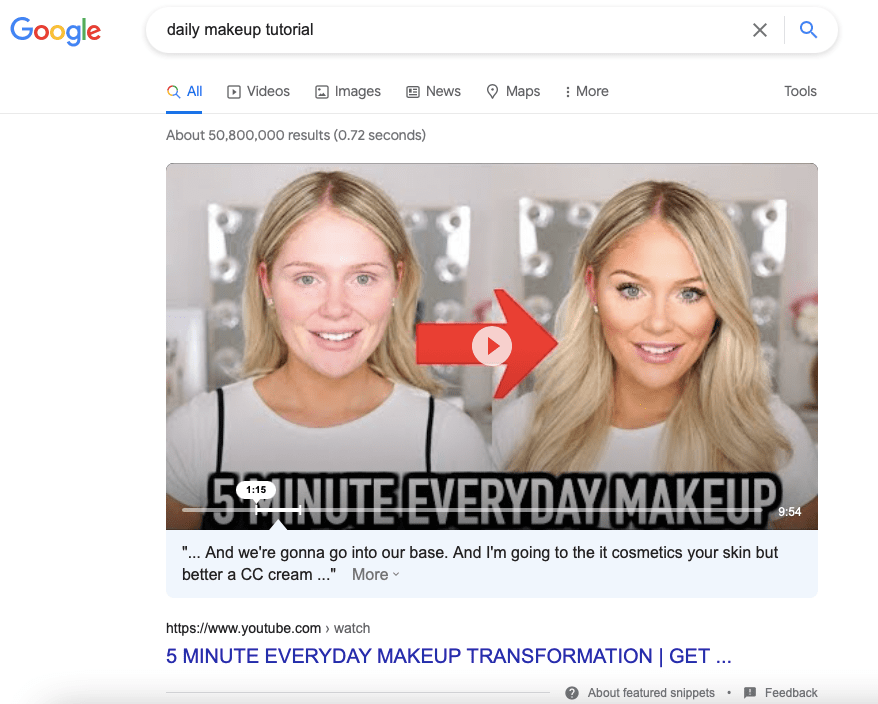
List snippets
Lists are a great way to structure information and make it more digestible. A featured snippet can contain a bulleted or numbered list which gets generated if a searcher looks for a set of items:
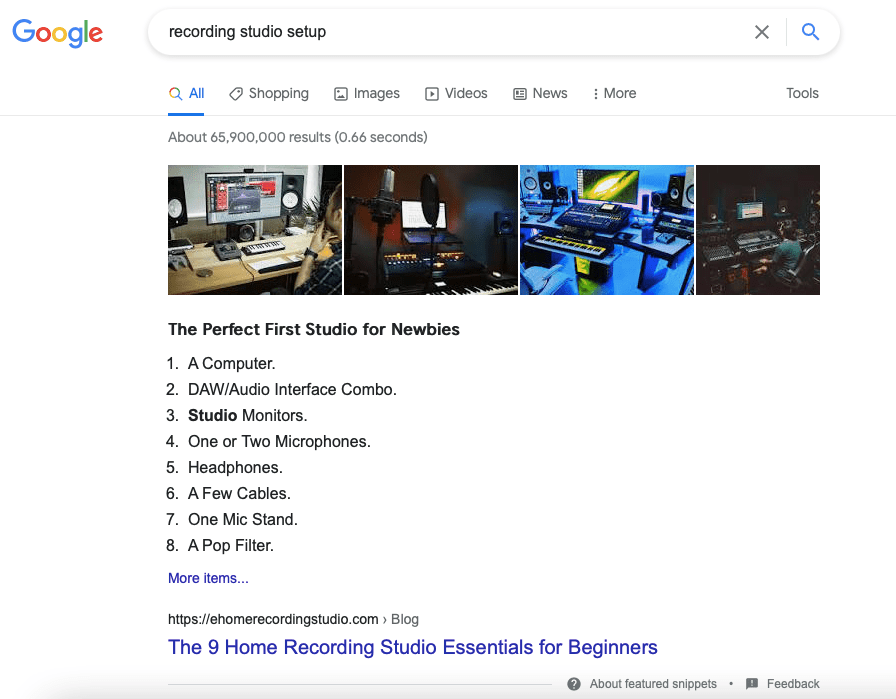
Or, when the search is about a multistep process:
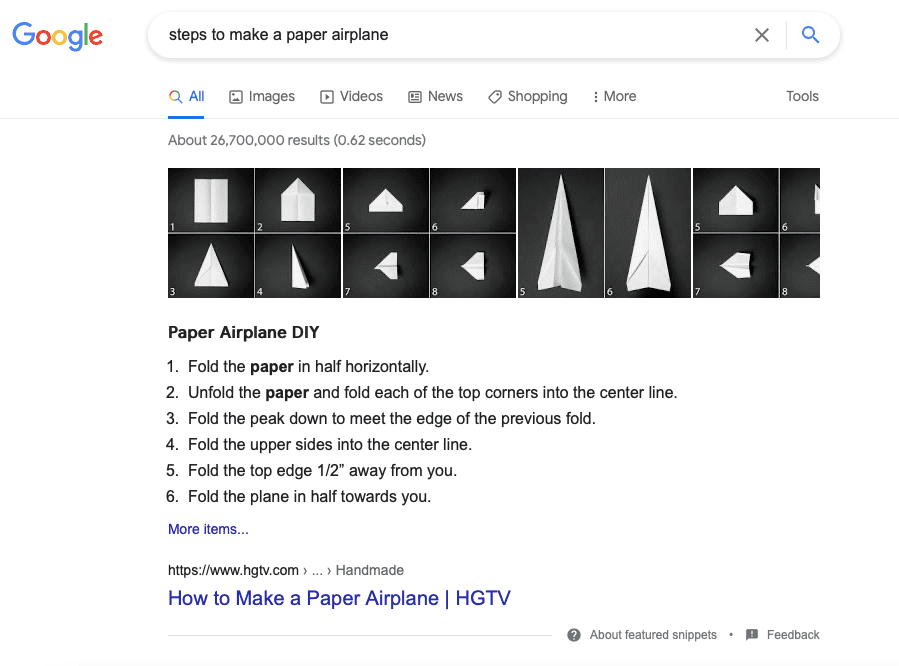
Interestingly, Google clearly understands when you’re asking something about one or several items. For example, “the most expensive car” and “the most expensive cars” queries will have totally different featured snippets while collected from a single source. In the former case, the snippet is a single paragraph about a car that’s topping the list, while in the latter case, the snippet is a list of cars with their estimated prices:
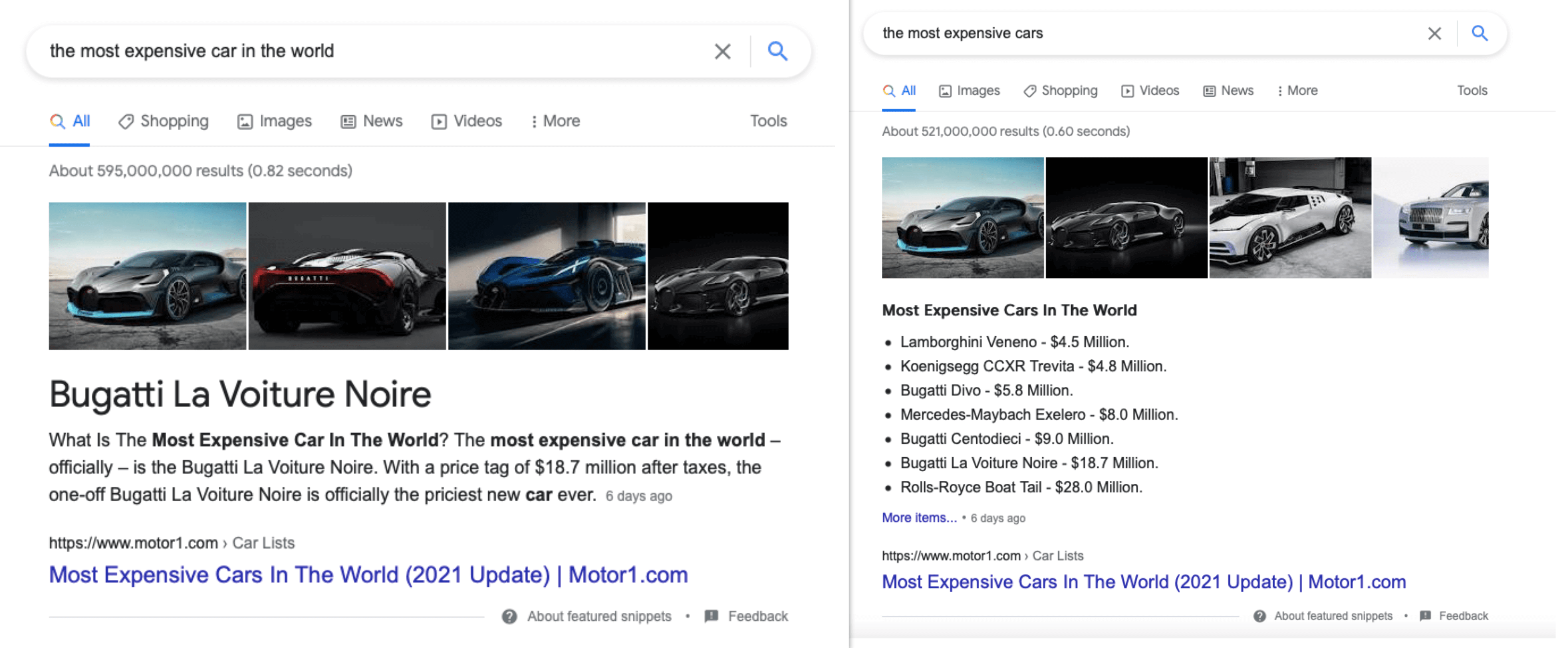
Table snippets
Another typical featured snippet is a table that highlights a part of the table present on the page. It’s usually generated for queries related to rankings and comparisons. Users can see how many rows are included and expand them right in the snippet.
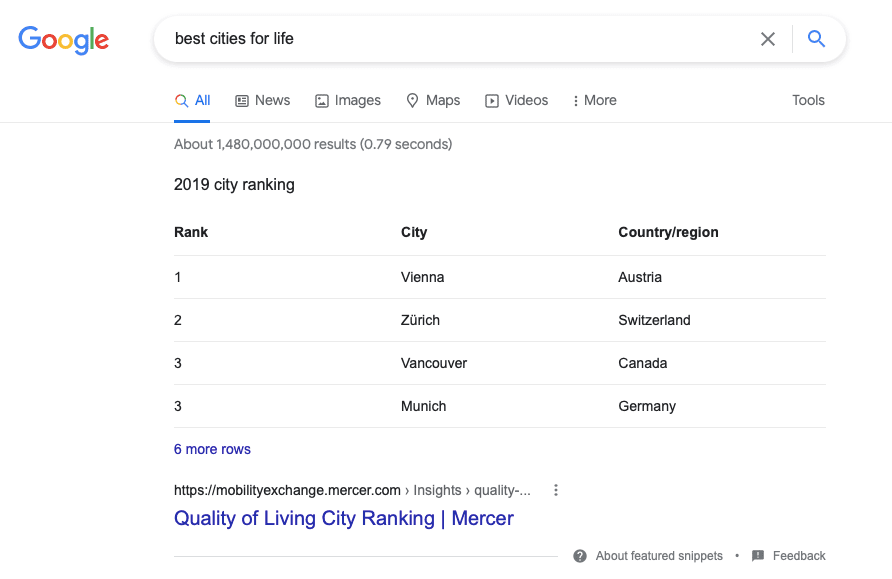
Carousel snippets
Carousel in search most often means a range of images or products that can be expanded on click. However, a carousel featured snippet refers to a snippet that can be tweaked with the help of bubble modifiers. For instance, when users search for tutorials that differ from one device to another and don’t include the device of interest in the query, they might see this type of featured snippet:
Clicking on each of the bubbles will result in a different page getting featured.
Combined snippets
A combined featured snippet displays several web pages, making them part of a single unified text about a certain phenomenon. For example, a search about “website authority” results in a snippet that collects a basic definition from one source and combines it with two subsections, popular to the topic, obtained from two other sources:
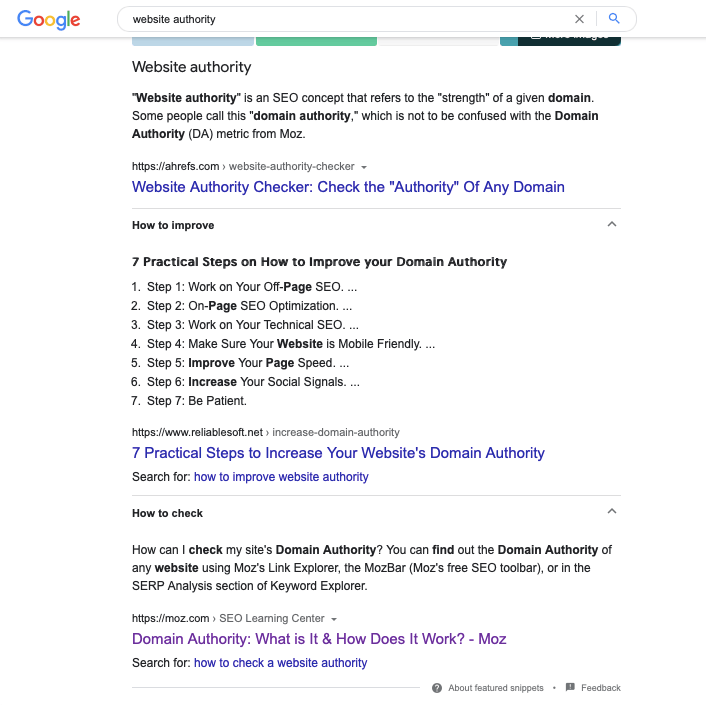
Double snippets
Sometimes, Google can’t decide between two sources and shows both in hopes that one of them will be suitable for the searcher. For example, these two lists are shown within a single featured snippet:
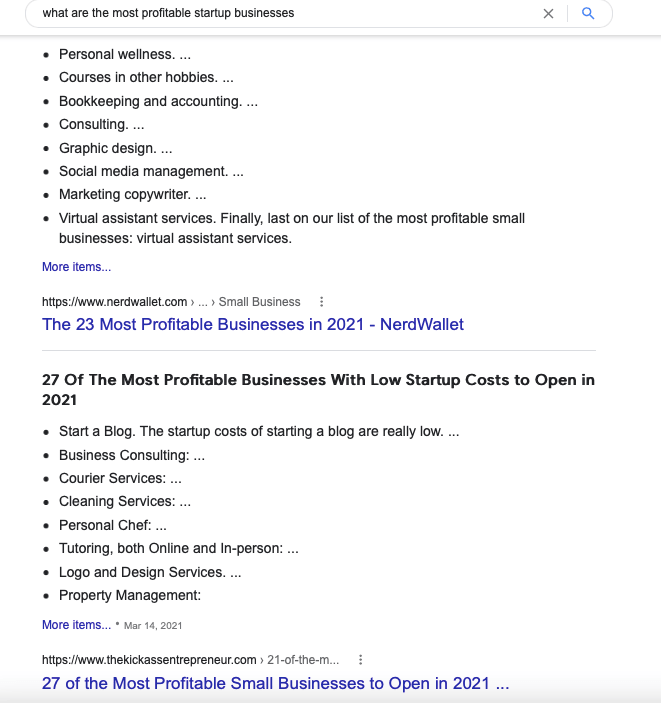
How are featured snippets different from rich results?
Rich, as well as enriched, results also stand out in the SERP, but they are linked to particular types of content: recipe, video, job listing, event, book, song, etc. A knowledge panel that provides a structured summary of the information about a person, company, or any particular item is also a kind of rich result.
Sometimes, Google’s featured snippets include structured data and resemble knowledge panels. For example, the “flowers for algernon” query will generate a knowledge panel on the right side, while “flowers for algernon summary” will show Wikipedia as a featured source:
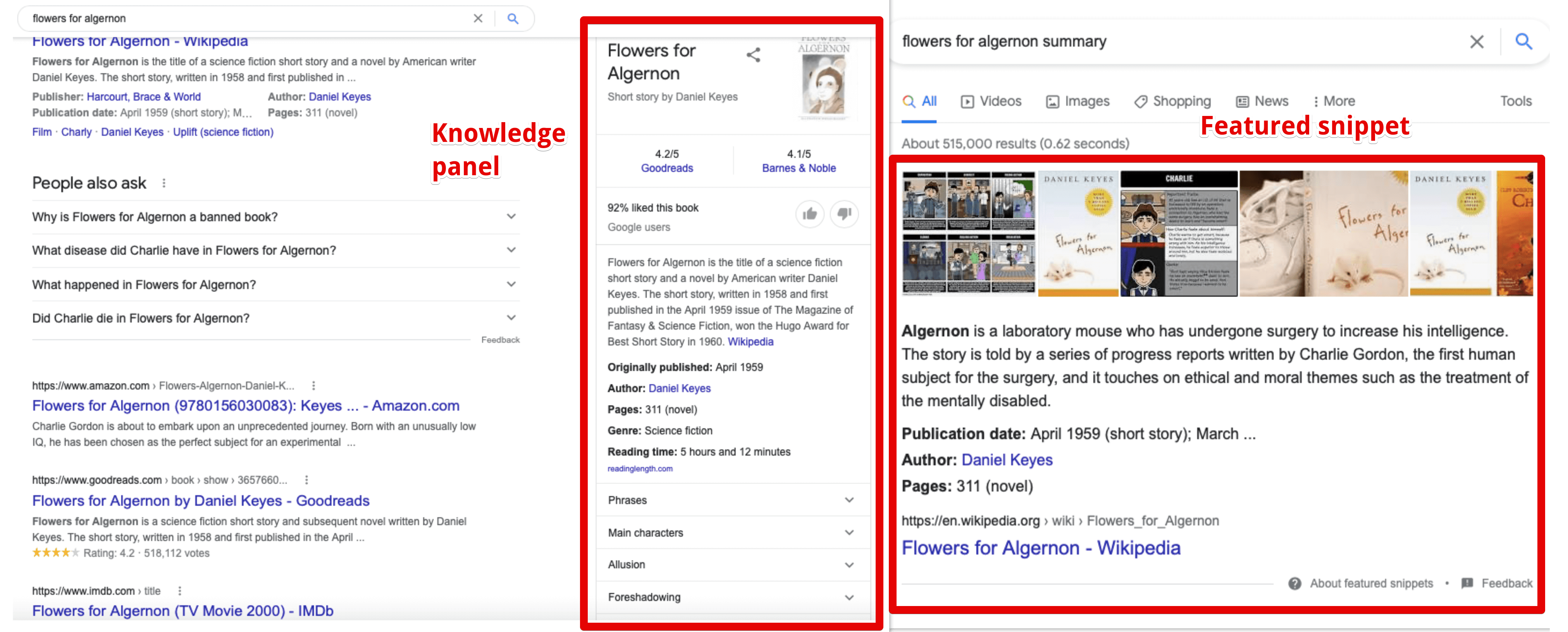
There are straightforward recommendations for getting rich snippets for a web page, which are to utilize structured data to label specific content and help Google understand it. With featured snippets, on the other hand, you don’t have super-specific guidelines to follow and things you can do to get one are more about general content optimization and not technical formatting.
What is not a featured snippet?
In the multi-faceted world of the SERPs, a lot of them appear to be distinctive boxes around Google’s search results that might be confused with featured snippets. The easiest way to know for sure if what you’re seeing is a featured snippet is to spot the “About featured results” note below the block.
People also ask
The People also ask box is a set of suggestions with queries similar to one in action. Each query has its own featured source and users can expand the information presented in this box. Even though this section isn’t popular—only 3% of users interact with it according to a Backlinko study—it’s still nice to show up among the results for additional searches.
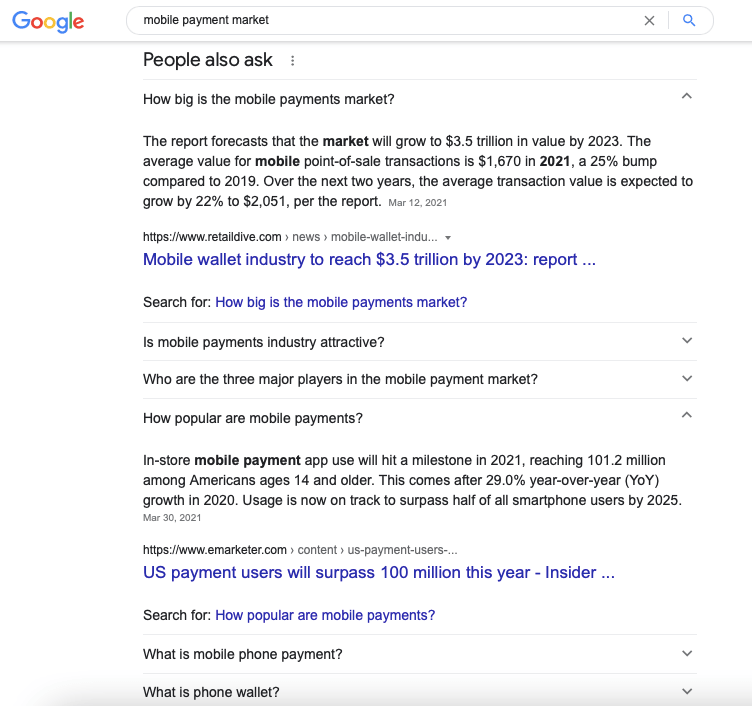
Knowledge panel
We’ve already shown what a knowledge panel looks like. It can be dedicated to a person, particular item, event, or phenomenon, as well as a brand. Google accumulates information from official sources into the panel but it’s also possible for third-party websites to rank in the panel of some company or product. Google identifies popular related subtopics and includes them in the knowledge panel, each coming from a different source:
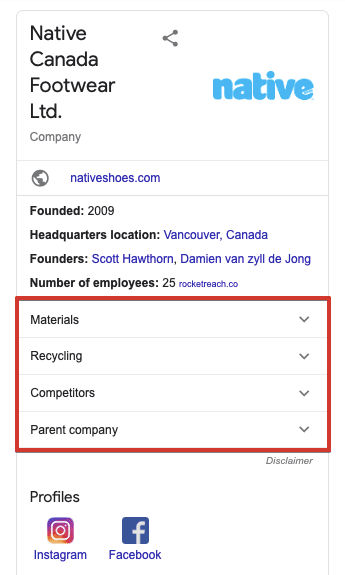
Reviews, Questions & Answers
The knowledge panel is often followed by blocks with reviews and Google Questions & Answers:
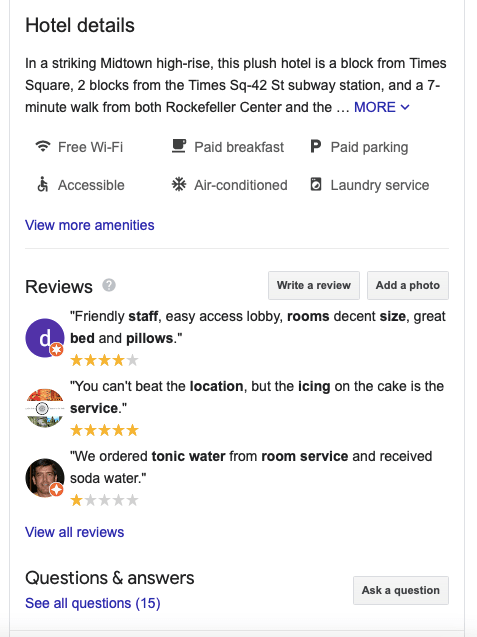
You should only care about user-generated content if you’re promoting a business which can be reviewed online. Using a Google My Business account, you can answer the questions related to your company to claim and control the knowledge panel.
Local Pack
Local Pack is another distinctive SERP feature that takes a lot of screen space. It’s a map that shows places of searcher’s interest according to their location or the one specified in the query:
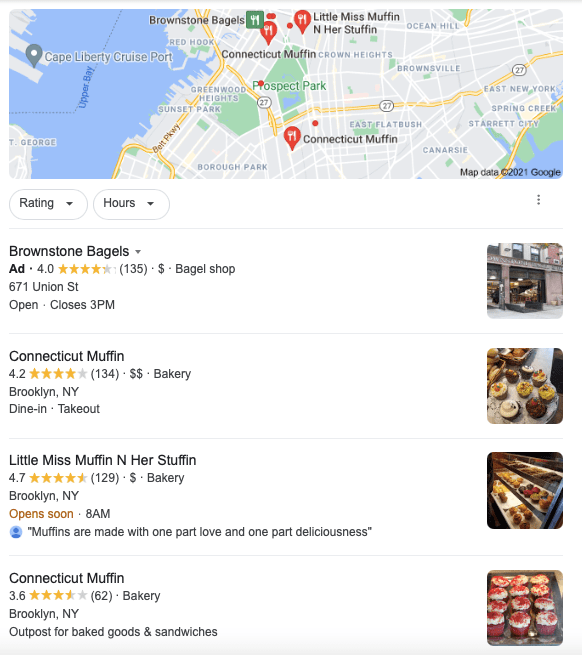
Products
The list of popular products often appears among the search results for commerce-oriented queries. Like carousel featured snippets, this block can also have bubbles with specifications:
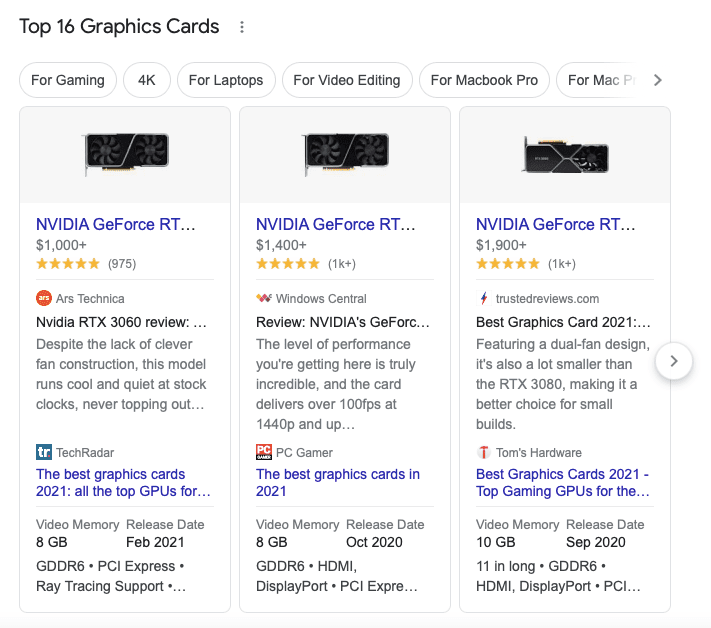
Blocks with local businesses and products serve a completely different purpose than featured snippets: they don’t aim to provide informative answers but offer the most relevant product or service options.
Sitelinks
A result showing clickable website sections is called sitelinks and is generated thanks to a proper site structure:
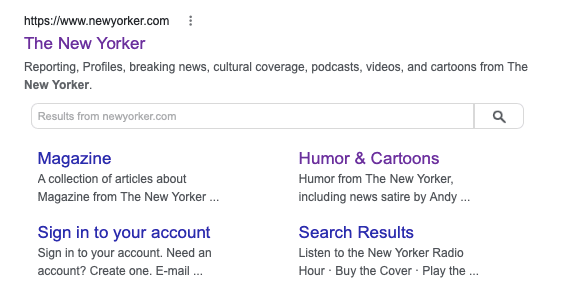
Definitions and one-box answers
The search engine might provide an answer to a query in the form of a dictionary definition or a short and very specific answer box pulled out from Google’s databases:

It doesn’t make sense to optimize for such queries. Instead, focus on more complex queries related to your niche—this is how you can rank in featured snippets.
Ambiguities of featured snippets and improvements by Google
As the mechanism behind the creation of featured snippets is tightly linked to the words used in a query, sometimes it gets too literal instead of looking for semantic connections. For example, we put the search engine’s capabilities to the test by asking it about a controversial topic. We used three slightly different queries about fairness that asked the same question and received very different results: a definition, a clear subjective answer, and a totally unrelated snippet.
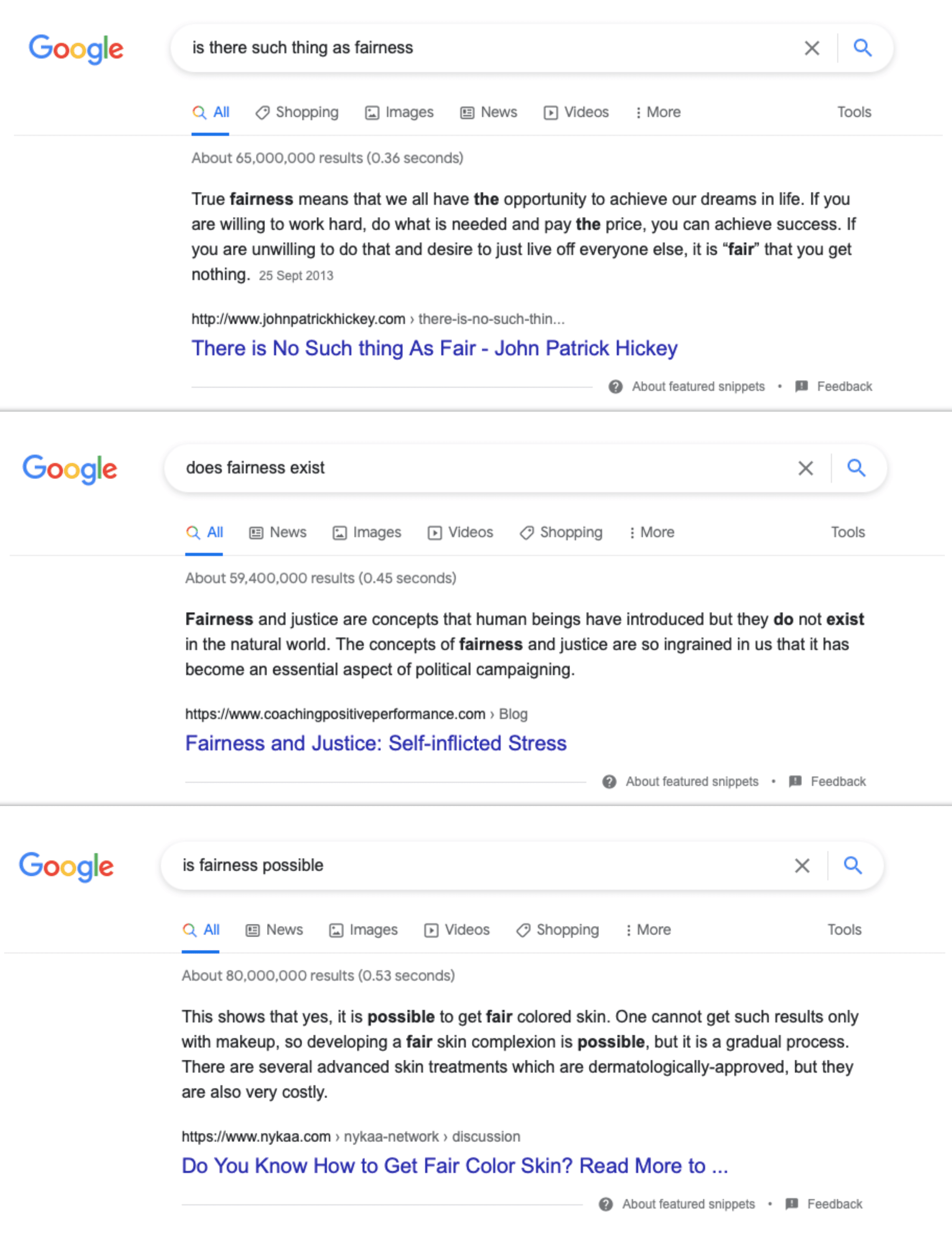
That being so, Google can fail to understand the meaning behind individual words and their combinations. Search engines may understand the context differently depending on keyword synonyms, so doing keyword research and filtering different variations of queries is always on point for a good SEO strategy.
Google knows about its problems, as well as about the pitfalls of controversial topics. For instance, some of the unfortunate snippet situations made a bunch of American presidents Klu Klux Klan members or claimed that the current president was not in fact president but King. Other inaccuracies used as an example in Google’s blog involved sensitive topics receiving antithetical featured snippets based on the query variation: when users want to know if it’s legitimate to have reptiles as pets, they might input “are reptiles good pets,” as well as “are reptiles bad pets.” In the perfect search world, they should get the same objective answer that illustrates what it means to domesticate reptiles. But sometimes they get answers linked to particular word choices and therefore a particular point of view.
In response to these problems and criticism, Google updated search quality rater guidelines, focusing on better identifying low-quality content that shouldn’t be put on position zero. Besides hiring search quality raters to assess the quality and accuracy of results, Google integrates new technologies to improve the search. Thanks to AI and neural networks application, Google is learning to understand and distinguish subtopics, which is also helpful with the generation of relevant featured snippets.
In 2018, the company claimed that “the vast majority of featured snippets worked well,” but some concerns about the snippets’ correctness are still the same, especially when it comes to YMYL queries. YMYL (Your Money or Your Life) is content that can have a direct impact on people’s lives. When people are searching for advice on stressful topics related to health or financial wellbeing, they shouldn’t be misled. Moz’s discovery of a dramatic drop in the number of featured snippets in February and March 2021, with the biggest shortage of YMYL snippets, tells us that Google continues tweaking its algorithms and tries to evaluate the snippet-to-be content more thoroughly.
While the accuracy of featured snippets is still a pressing issue, a lack of trust toward them might have nothing to do with the quality of their information.
People trust featured snippets… But they also don’t
Hubspot’s 2017 survey revealed that a lot of people didn’t trust featured snippets: only 7% of respondents found them trustworthy, while 21% believed they never showed the right information. EngineScout’s study we’ve mentioned confirms that trust is the biggest issue when it comes to featured snippets: a lot of searchers (24%) believe that those snippets are ads.
Given that ad blocks are often displayed above organic results, we can understand where this lack of trust is coming from. This issue won’t disappear until Google cooperates with advertisers, so probably never. You might just keep in mind that no matter how informative your content and how well it is picked for a featured snippet, some searchers will still avoid it.
Now as we went through the major aspects of Google’s snippets, their value for traffic, and the way they are perceived, let’s discuss how to get featured snippets for your website.
How to optimize for featured snippets?
You can’t directly impact how featured snippets will, or will not, be generated for your web pages. But there are certain things you can do if you want to shine in the SERPs on position zero.
Focus on high-volume long-tail keywords
It’s been observed that the more popular a query, the more likely it will have a featured snippet. Same goes for the number of words in a query: long-tail keywords get the biggest share of snippets.
Examine your website’s keyword list and pick the queries with the most potential. Then, think of the web pages that are likely to grab searchers’ attention from a small paragraph that contains one of the picked queries.
Provide short informative answers
Most featured snippets address a question-based query: it’s a “what is,” “how to,” or “how many” that will trigger a snippet. Interestingly, you might not even include the very same wording, and the search engine will still understand what you mean. For example, the “how many apps” query receives a featured snippet triggered by the “key mobile app statistics” heading:
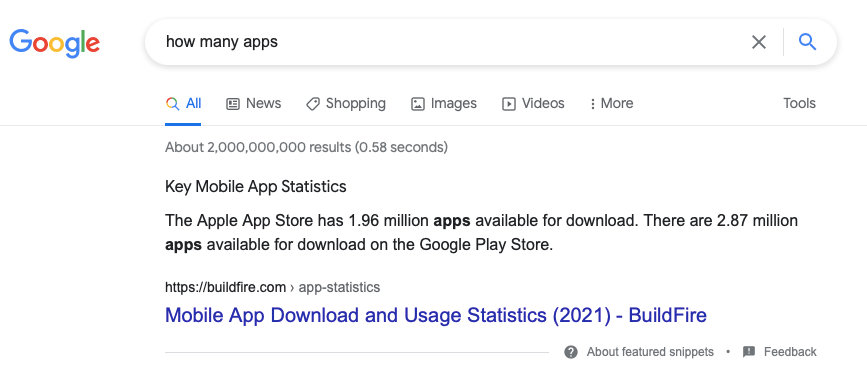
Again, revise your website’s keyword list and filter the queries that are formulated like questions or contain words like “explanation,” “statistics,” “examples,” and so on. An informative Q&A section might also get you a featured snippet. You can mark up FAQs using structured data so that Google easily understands this content and helps you reach the right users.
The BambooHR case shows that putting question-based keywords into headings actually works. After website SEOs discovered that definitions are the biggest trigger for featured snippets in their niche, they put “what is” keywords in H2 and won the snippets.
Note that your answers should be concise and easily understood by both search engines and users. According to the SEMRush and Brado study, the vast majority of featured snippets are short paragraphs containing no more than 250 characters. Learn if the paragraphs on your web pages that address particular questions are readable and not too long, and consider rephrasing if they are.
However, never compromise on informativeness for the sake of length. For instance, Investopedia owns a featured snippet for “deep learning explanation” and gives a short but profound answer taking over 300 characters. The source that comes first in the SERP but doesn’t have a snippet offers a shorter definition which is less helpful and would look less trustworthy above the results:
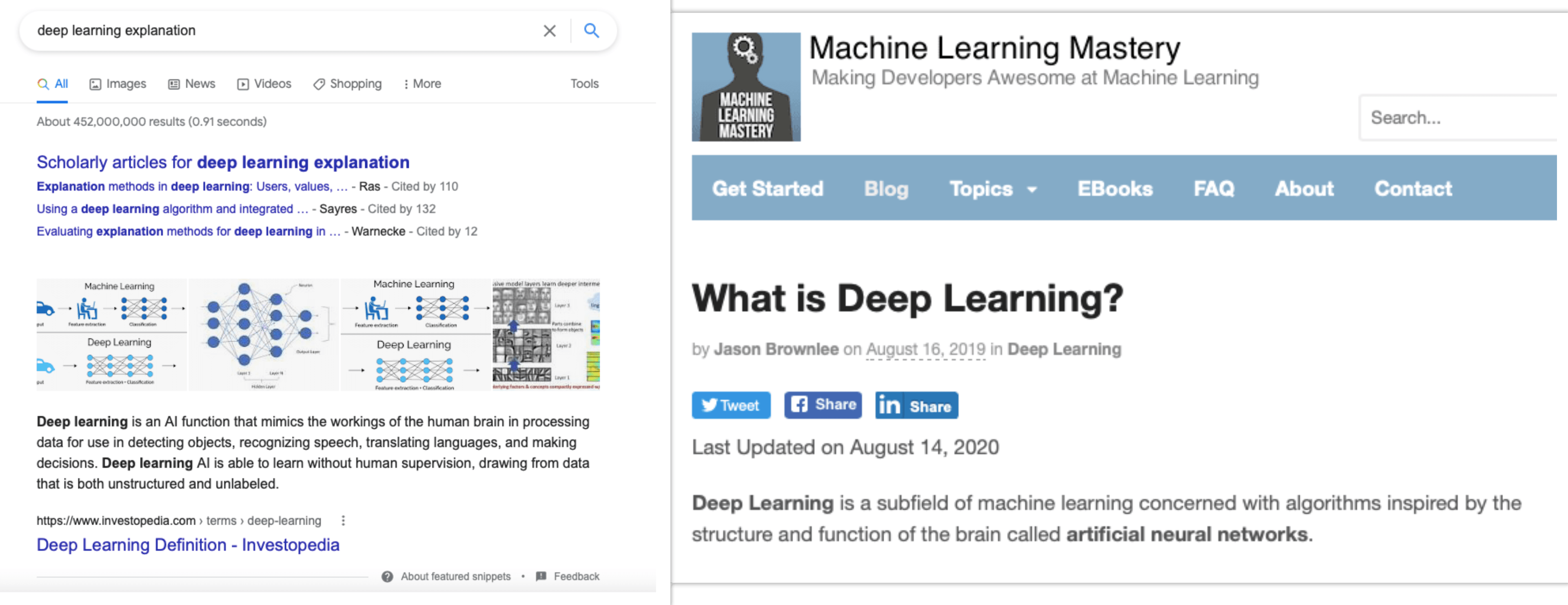
Format your content
Featured snippets often rely on headings and lists so make sure to work on a proper content structure and use bulleted and numbered lists whenever relevant. Diversify your content with high-quality images as well: they often accompany the information given in a snippet.
There’s no universal answer regarding the quantity, but SEMRush has discovered that web pages that are featured-snippet material have 14 headings and 8 images on average.
Speaking of the Schema markup that helps label specific types of content, it doesn’t impact your chances with featured snippets, but it is a generally recommended SEO practice that helps getting rich snippets.
Start from the most fundamental information
It is believed that the inverted pyramid technique is a smart way of getting featured snippets. The inverted pyramid means starting from the most fundamental information and then going into the less important details. If it doesn’t affect the writing style, it’s a good idea to place the most important statements at the beginning of each paragraph.
How to track featured snippets?
There’s no direct way to check and track your featured snippets in Google Search Console, as well as any other SERP features. There’s a trick of adding the “#:~:” page filter which corresponds to the position zero, but no one knows for sure if it works for all featured snippets.
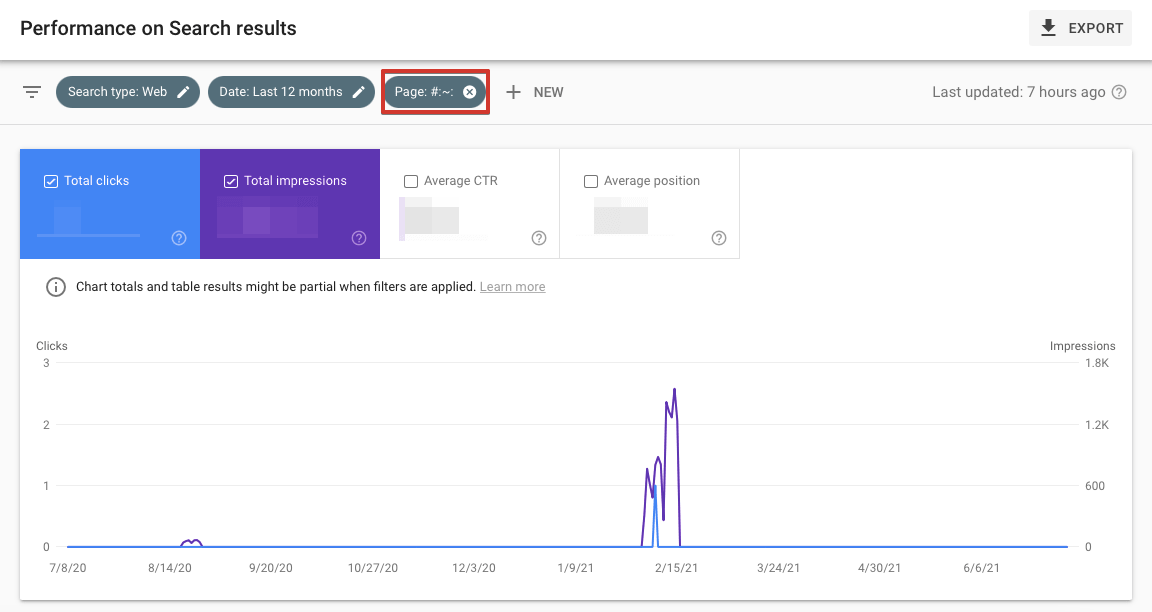
There are SEO tools at your disposal that give more information about snippets. In the Rankings module of SE Ranking, you can check which of the added keywords have featured snippets and if your website owns any of them. Look at the SERP Features column:
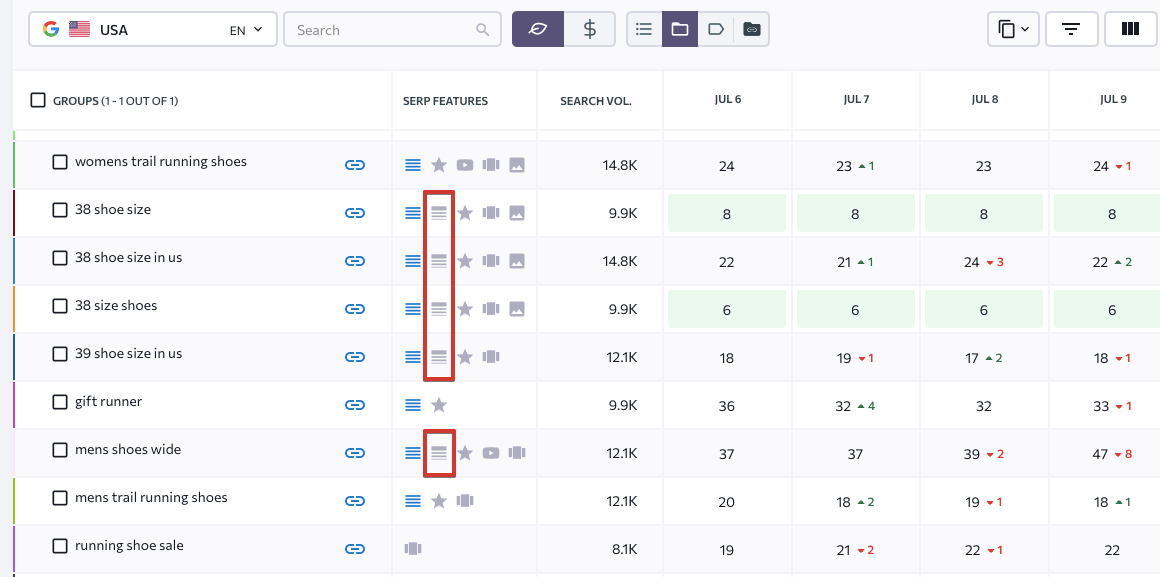
If the featured snippet icon is highlighted in blue, it means your web page ranks above the rest of the results. Track the traffic of that page keeping in mind the featured snippet so that you can evaluate how beneficial it is to get featured in the search.
If the featured snippet icon is highlighted in grey, it indicates that another page owns it. You can examine that competitor page and extract some insights to do better with your content and win over that snippet.
If there’s no featured snippet icon in the column, it isn’t generated for this query. But it doesn’t mean it won’t be, so keep working on the chosen keywords. By the way, you can leverage SE Ranking’s SERP Tracker to see what SERP features are available for any keyword, anywhere.
Snag those featured snippet boxes!
Featured snippets are visually appealing and informative answers to certain queries that can increase your website’s traffic and authority. By getting snippets, you’ll be able to steal users’ attention from other web results, especially in the context of mobile and voice search, and attract them to visit your pages.
Even if you don’t get the featured snippet, optimizing for one generally improves the quality of your content by making it more structured and easily readable. So it won’t hurt chasing the snippets, but before you do, learn what keywords from your website’s semantics with a sufficient search volume are most susceptible to featured snippet generation.
What’s been your experience with featured snippets? Have you spotted a traffic boost after getting one? Share in the comments!

